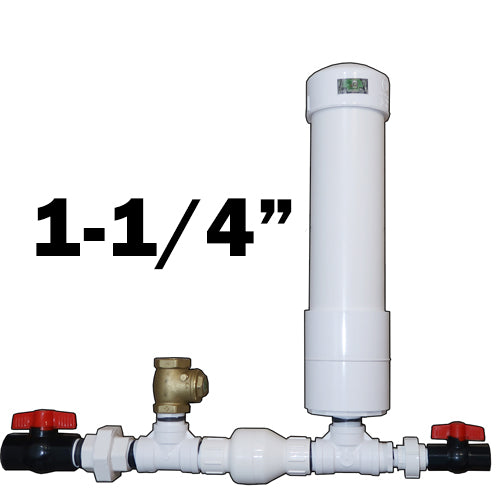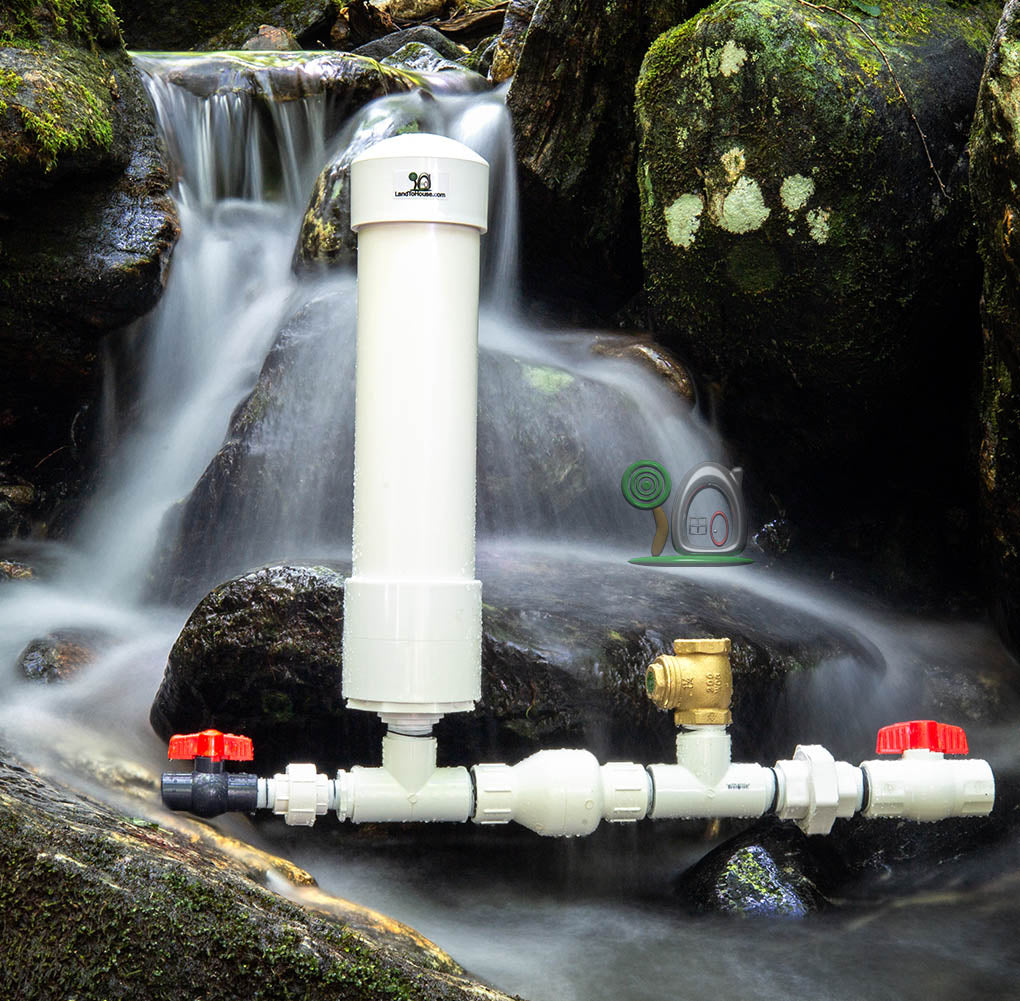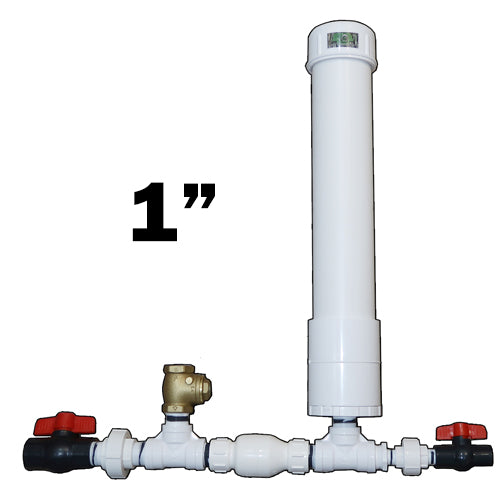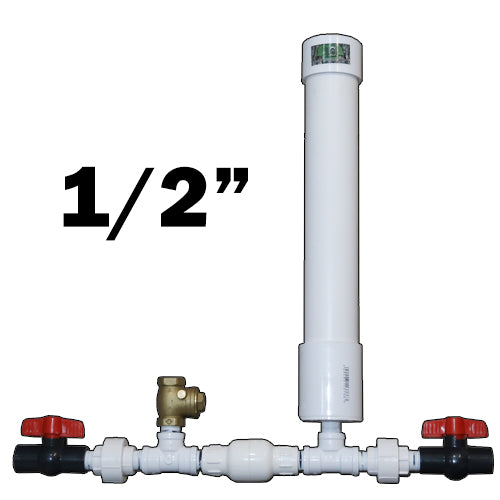Land To House Store
Ram Pump Fully Assembled
Ram Pump Fully Assembled
Couldn't load pickup availability
The Hydraulic Ram Pump is a Water Pump that does not need fuel or electricity to operate. Only flowing and falling water is needed. These pumps are fully assembled so you will only need to install a drive pipe and delivery pipe to get them going.

All Pumps require a minimum input head pressure (water drop from source to pump) of 2.5 feet.
What size pump is right for you?
There are four sizes of Ram Pumps. The difference in size is the amount of water required to operate the pump and the expected output at the top. Each size Ram Pump can lift to the same height. This works on a 1:7 ratio of input head pressure to lift. For every additional 1 foot of head pressure going into the pump you can expect 7 feet of lift out the delivery pipe.
The Ram Pump needs these minimum water flow rates depending on pump size:
------------------------------------
All Components used in the Ram Pump are Lead Free.

Each Ram Pump has a waste valve made from Lead Free Brass. This swing valve closes to allow the Ram Pump to cycle.
------------------------------------
4 Steps to Buying a Ram Pump
1. Determine your Water Flow Rate.
The ram pump needs flowing water to operate. The amount of water that you have available in the creek, determines the size ram pump that you can use.
Here are the flow rate specs for each size of ram pump available on Land To House:
1/2″ Ram Pump 2gpm(7.6Lpm)
3/4″ Ram Pump 4gpm(15Lpm)
1″ Ram Pump 6gpm(22.7Lpm)
1-1/4″ Ram Pump 8gpm(30.3Lpm)
The Ram Pump will consume the minimum flow rate. during normal operation. This amount of water is going to be used regardless if more water is available in the creek.
How to measure flow rate? Fill a 5 gallon bucket from the water source and time how many seconds it takes to fill. Divide 300 by the seconds calculated and you will have the Gallons per Minute.
Example: 28 seconds to fill a 5 gal bucket: 300/28 = 10.7 gallons per minute

2. Determine your Head Pressure (water drop from source to pump)
The Ram Pump needs falling water to utilize the water hammer effect (ram). This is called Head Pressure. The pump works on a 1:7 ratio input head pressure to lift. For example if you have 10 feet of head pressure the pump will lift 70 feet vertical.
There are a few ways that you can determine the head pressure.
A. Take a garden hose and lay it in the creek. Let water run into the upper end. Lift the lower end up until the water stops flowing. Measure the distance from the surface of the water to the hose end. This is the head pressure available to the pump.
B. Place a garden hose in the creek and use a gauge that reads psi (pounds per square inch). Convert the psi to feet by using: psi/.433=feet of head.
C. Use a site such as Google Earth to find the elevation of the upper and lower parts of the creek and subtract the lower number from the higher number to find the head pressure.

3. Determine the Lift height from the pump to where you need water
The main limiting factor of the ram pump is the lift height of the water. The horizontal distance that water is pumped is not an issue.
There are a few ways to determine the lift height.
A. The easy way is to use a site like Google Earth to get a general idea of the lift height. Take the elevation of the highest point you need water and the elevation of the pump location. Subtract the lower elevation from the higher elevation and you will have the lift height.
B. Use a Clinometer. This tool finds angles of the incline and will let you use trig to find the height of lift.
C. Use a line level and tape measure to find level and measure down to the ground. This can be done in stages to find all the drops from the top of the hill to the bottom.
D. Fill a garden hose or pipe with water and use a psi gauge to find the height. psi/.433=feet of head.
4. Determine how much water you need in a day.
The amount of water that you need in a day is based on your own application. Here is what each ram pump size can supply in a day:
(Max output based on ideal setup)
1/2″ pump : 360 Gallons per day. (1211 Liter per day)
3/4″ pump : 720 Gallons per day. (2725 Liter per day)
1″ pump : 1080 Gallons per day. (4088 Liter per day)
1-1/4″ pump : 1440 Gallons per day. (5451 Liter per day)
Keep in mind that these numbers are based on ideal input head pressure and lift height. If you have less head pressure or you are lifting higher, your flow will be less.
------------------------------------
What else do you need to get the ram pump running?
-You will need a Drive Pipe to get water to the pump. This can be PVC or Poly Pipe. Be sure to match the pump size and the Drive pipe.-You need a Delivery Pipe to take water up hill from the pump. This can be any size you like. Garden Hose, PVC Pipe, and Poly Pipe are all good options.
-Depending on the pipes you select you will need fittings to connect to the pump.
- For PVC you will need adaptors from thread to socket. The ends of the ram pump have threaded ball valves. Then you will need couplings to connect sections of pipe.
- For Poly Pipe you will need barb fittings that go from thread to barb. Then you will need barb to barb connectors to join sections of pipe. Hose clamps are often needed to keep the poly on the barb.

Full Install of a Ram Pump and Filter Bucket:
Share










